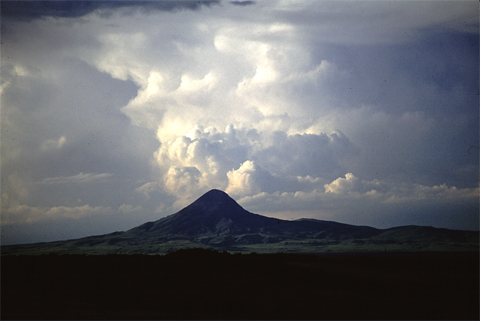On the morning of 4 June 1805, Lewis and Clark set out separately to explore the two puzzling rivers for a day and a half each. Lewis, who chose to follow the “wright hand fork,” climbed to “a commanding eminence” some four miles from camp, where he took the bearings of the mountains he could see from there—The Sweet Grass Hills and Bears Paw Mountains.
By his estimate, on 5 June 1805, Meriwether Lewis was 38 miles up the Marias River from the expedition’s camp on the Missouri. Looking northward, he saw “a lofty single mountain which appeared to be at a great distance, perhaps 80 or more miles . . . from it’s conic figure I called it tower Mountain.” It is now called the West Butte of the Sweet Grass Hills, which are igneous intrusions into the surrounding sedimentary Cretaceous rock, standing northeast of Shelby, Montana.
Lewis’s estimate of its distance from him was closer when he entered his courses and distances for that day, on 8 June 1805: He wrote “about 60 miles.” It is actually just under 60 miles (ca. 97 km) from Lewis’s probable location. He had already remarked that the clear air of the high plains made it difficult to estimate distances.
During the 1920s the Sweet Grass Hills were the scene of intensive oil and natural gas production.
To the northeast, an estimated 30 miles distant—he was about 10 miles short—he identified the “North Mountains,” which today are officially the Bears Paw Mountains, but locally are called the Bearpaws.
Could Lewis but have seen into the future, near and far, he would have recognized in that dark shadow on the horizon the symbol of a betrayal that would have caused him great disappointment, shame, and sadness.
Only 108 days later, on 20 September 1805, they were to emerge from the Bitterroot Mountains and meet some Nez Perce Indians—the Ne-Mee-Poo, “The People.” The Nez Perce had already heard of the Expedition from the Knife River Hidatsas, and welcomed them, fed them, and shared their wisdom and experience. Less than a year after that, in May 1806, the Corps of Discovery would return to reclaim the horses the Nez Perce had faithfully cared for, and spend a month among those kind, strong, charitable people while waiting for the winter’s snow to melt on the ridges of the Bitterroot Range. They would leave strong bonds woven between Nez Perces and Americans, which would last for nearly fifty years.
On 29 September 1877, a part of the Nez Perce nation, 750 men, women, and children who had resisted eviction from homelands they had never sold, and who refused to be confined to a reservation, were to make their last camp on Snake Creek, on the north flank of the Bearpaws.
Those “non-treaty” Nez Perce would have fought their way over 1500 miles to reach asylum in Canada. They would have by then stood off more than 2,000 U.S. Army soldiers and volunteers in three major battles and more than a dozen small engagements. At 6 a.m. on the 30th, they would be forced into the final battle by U.S. cavalry and infantrymen.
On 5 October, White Bird, one of two chiefs remaining alive, would creep northward through the ravines with some of the survivors to join Sitting Bull and his band of Sioux, who were fugitives from their previous year’s triumph over Custer on the Little Bighorn. Chief Joseph would surrender all that were left of the non-treaties—87 men, 184 women, and 147 children, who were too cold, sick, and hungry to resist anymore (see also Nez Perce Campaign of 1877).
They would be only about forty miles from the border. Just forty miles from freedom.
Experience the Lewis and Clark Trail
The Lewis and Clark Trail Experience—our sister site at lewisandclark.travel—connects the world to people and places on the Lewis and Clark Trail.
Discover More
- The Lewis and Clark Expedition: Day by Day by Gary E. Moulton (University of Nebraska Press, 2018). The story in prose, 14 May 1804–23 September 1806.
- The Lewis and Clark Journals: An American Epic of Discovery (abridged) by Gary E. Moulton (University of Nebraska Press, 2003). Selected journal excerpts, 14 May 1804–23 September 1806.
- The Lewis and Clark Journals. by Gary E. Moulton (University of Nebraska Press, 1983–2001). The complete story in 13 volumes.


